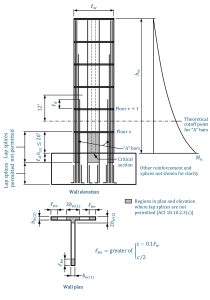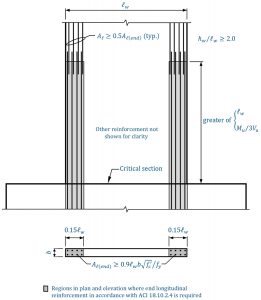Part 1: Significant Changes to the Design and Detailing Requirements
Significant changes were made to the design and detailing requirements for special steel-reinforced concrete structural walls in the 2019 edition of Building Code Requirements for Structural Concrete (ACI 318-19) (hereafter referred to as ACI 318). According to ASCE/SEI 7-16, Minimum Design Loads and Associated Criteria for Buildings and Other Structures, special structural walls are required in buildings with bearing walls, building frames, and dual systems assigned to Seismic Design Category (SDC) D, E, or F.
The following revisions to the design and detailing requirements can be found in Sects. 18.2.6 and 18.10 of ACI 318:
- The introduction of Grade 80 and Grade 100 deformed bars to resist the effects from flexure, axial force, a combination of axial force and flexure, and shear.
- New requirements for longitudinal bar termination and splice locations.
- New requirements for minimum area of boundary longitudinal reinforcement for slender walls.
- Increase of the design shear force for slender walls.
- New requirements for expected wall deformation capacity and expected wall drift demand.
- Revised details for transverse reinforcement within boundary elements and the wall web.
- New maximum vertical spacing requirements of transverse reinforcement at wall boundaries.
The requirements for Items 1 through 3 are covered below; Items 4 through 7 will be covered in a future article.
High-Strength Reinforcement
Recent advances, including substantial new research, have enabled reinforcing steels of higher strengths to be a viable option in a variety of applications in reinforced concrete structures, including buildings with special structural walls (see the CRSI Technical Notes Guide to the Use of Grade 80 Reinforcing Bars in ACI 318-19 and Guide to the Use of Grade 100 Reinforcing Bars in ACI 318-19). Permissible applications of high-strength steel reinforcement (that is, reinforcement with a yield strength of 80,000 psi or 100,000 psi) were significantly expanded in the 2019 edition of ACI 318. For special structural walls, ASTM A706 Grade 80 and Grade 100 deformed reinforcing bars are permitted to be used to resist the effects of flexure, axial force, and a combination of flexure and axial force. Similarly, ASTM A615, A706, A955, and A996 Grade 80 and Grade 100 deformed reinforcing bars are permitted to resist shear effects. All components of special structural walls, including coupling beams and wall piers, are permitted to use this reinforcement.
According to ACI 318 Table 19.2.1.1, the minimum specified compressive strength of the concrete, f´c, for special structural walls with Grade 60 or Grade 80 reinforcement is 3,000 psi; for walls with Grade 100 reinforcement, minimum f´c is 5,000 psi. The higher minimum compressive strength for Grade 100 reinforcement enhances bar anchorage and reduces the neutral axis depth for improved overall performance.
Utilizing high-strength steel reinforcement in special structural walls typically results in smaller bar sizes and/or fewer bars than Grade 60 reinforcement. This translates to improved concrete placement and consolidation and a reduction in reinforcing bar congestion, especially in walls with coupling beams. It also results in lower placement costs because fewer bars need to be placed in the field.
Longitudinal Reinforcement
Termination and Splice Locations
New requirements for termination and lap splice locations of longitudinal reinforcement in special structural walls are given in ACI 318 Sect. 18.10.2.3.

Except at the top of a wall, longitudinal reinforcement must extend at least 12 feet above the point where it is no longer required to resist flexure but need not extend more than a tension development length, ld, above the next floor level, where ld is determined in accordance with ACI 318 Sect. 25.4.2.3 or 25.4.2.4. This requirement is illustrated for the termination of the “A” bars in Figure 1. The limit of 12 feet accounts for buildings with relatively large story heights.
At locations where yielding is likely to occur because of lateral displacements (like the base of a cantilever wall), ld must be multiplied by 1.25. This factor accounts for (1) the likelihood that the actual yield strength of the reinforcement exceeds the specified yield strength, fy and (2) the influence of strain hardening and cyclic load reversals. Extending longitudinal bars a distance of ld above the next floor level is a more practical approach for bar development than the requirements in previous editions of ACI 318.
Lap splices of longitudinal reinforcement within defined boundary regions are not permitted over a story height, hsx, above a critical section and a distance of ld below a critical section where the value of hsx need not exceed 20 feet (see Figure 1 for the case of a single critical section at the base of a wall where yielding of the longitudinal reinforcement is likely to occur as a result of lateral displacements). Boundary regions, in this case, include those within the lengths specified in ACI 18.10.6.4(a) for the horizontal extent of special boundary elements and within a length equal to the wall thickness measured beyond the intersecting region(s) of connected walls (see the shaded areas indicated on the wall plan in Figure 1). Test results have shown that the inelastic deformation capacity of a structural wall is significantly reduced where lap splices are located at or near the critical section.
Minimum Area of Boundary Longitudinal Reinforcement
A minimum area of longitudinal reinforcement must be provided at the ends of structural walls or wall piers that are slender (that is, the overall height-to-length ratio, hw/lw is greater than or equal to 2), are essentially continuous from the base of the structure to the top of the wall, and are designed to have a single critical section for flexure and axial loads. According to ACI 318 Sect. 18.10.2.4, the minimum longitudinal reinforcement ratio within 0.15lw from the end of a vertical wall segment and over a width equal to the thickness of the wall, b, must be 6√f´c/fy (see Figure 2, where the minimum longitudinal reinforcement ratio requirement is given in terms of the minimum area of reinforcing steel, Al(end)).

This requirement intends to promote the formation of well-distributed secondary flexural cracks in the wall plastic hinge region, thereby reducing the potential for reinforcement fracture at these locations. The minimum required distances above and below the critical section where the minimum longitudinal reinforcement must be provided are the greater of lw and Mu/(3Vu); these are the lengths over which yielding is expected. The terms Mu and Vu are the factored bending moment and shear force at the critical section, respectively, obtained from analysis of the building using code-prescribed seismic forces.
No more than 50 percent of the minimum longitudinal reinforcement is permitted to be terminated at any one section of the wall; this requirement intends to avoid a weak section in the wall adjacent to the anticipated plastic hinge region.
More in-depth information on the changes outlined in this article, including design aids and worked-out examples, can be found in the CRSI Design Guide on the ACI 318 Building Code Requirements for Structural Concrete. Also available is the CRSI Design Checklist for Special Steel Reinforced Concrete Structural Walls, which contains an easy-to-use list of essential items that must be completed when designing and detailing special structural walls. Visit www.crsi.org for more information on these and other CRSI resources.■
References
ACI (American Concrete Institute). 2019. Building Code Requirements for Structural Concrete and Commentary. ACI 318-19, Farmington Hills, Michigan.
American Society of Civil Engineers (ASCE). 2017. Minimum Design Loads and Associated Criteria for Buildings and Other Structures, ASCE/SEI 7-16, Reston, VA.
CRSI (Concrete Reinforcing Steel Institute). 2020. Guide to the Use of Grade 80 Reinforcing Bars in ACI 318-19. ETN-D-7-20, Schaumburg, IL.
CRSI (Concrete Reinforcing Steel Institute). 2020. Guide to the Use of Grade 100 Reinforcing Bars in ACI 318-19. ETN-D-6-20, Schaumburg, IL.
CRSI (Concrete Reinforcing Steel Institute). 2020. Design Guide on the ACI 318 Building Code Requirements for Structural Concrete. Schaumburg, IL.
CRSI (Concrete Reinforcing Steel Institute). 2022. Design Checklist for Special Steel Reinforced Concrete Structural Walls. Schaumburg, IL.
